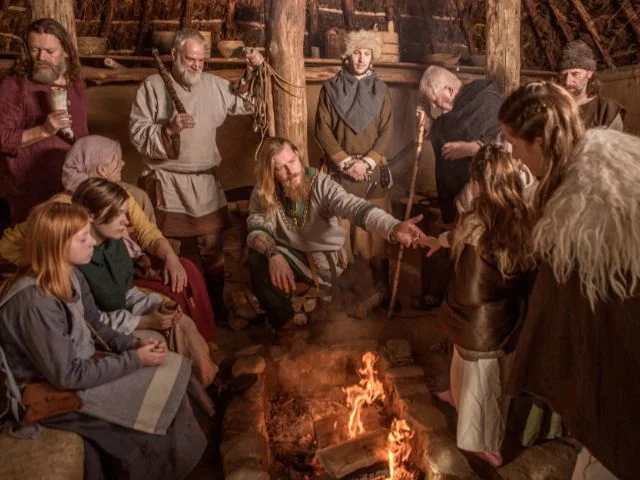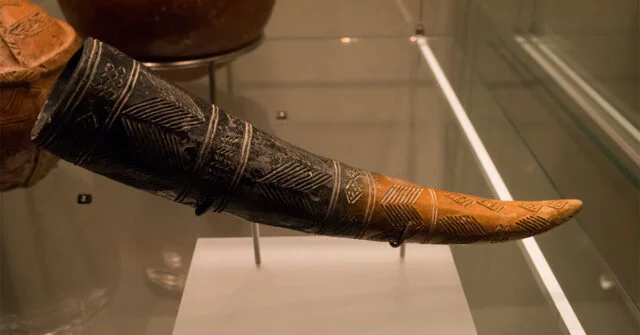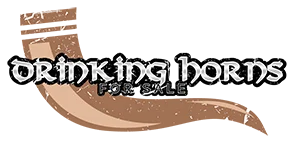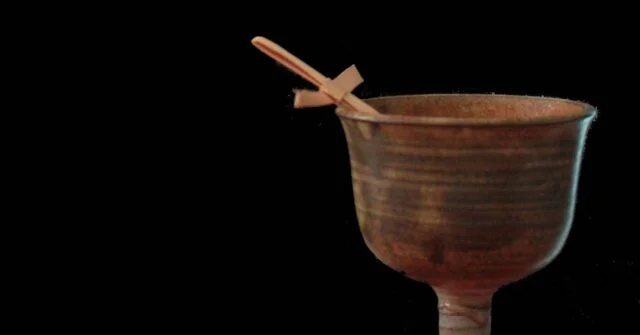The Vikings, a group of people who lived in Scandinavia from the 8th to the 11th century, are often remembered for their raids and exploration.
However, their daily life, culture, and traditions hold fascinating aspects as well, particularly their drinking customs.
This blog post explores the various vessels Vikings used for drinking, focusing on the iconic drinking horn, and provides insights for those interested in owning or purchasing a drinking horn today.

The Historical Context of Viking Drinking Customs
Drinking played a pivotal role in Viking society, not just for hydration but as a significant part of their social and ceremonial practices.
Let’s delve into the beverages they enjoyed and the context of their drinking traditions.
The Importance of Drinking in Viking Society
In Viking society, drinking was a communal activity that fostered bonds among family, friends, and warriors.
Mead halls, large buildings where people gathered to eat, drink, and socialize, were central to these communities.
Here, stories of gods, heroes, and adventures were shared, reinforcing social ties and cultural norms.
Common Beverages Among Vikings
Vikings drank a variety of beverages, including water, milk, fruit juices, and alcoholic drinks like mead, beer, and ale.
Mead, made from fermented honey and water, was particularly celebrated and often associated with poetry, inspiration, and the gods themselves.

Drinking Vessels Used by the Vikings
The Vikings used different types of vessels for drinking, each with its own significance and use. These ranged from elaborately carved drinking horns to simple wooden cups.
Drinking Horns: The Symbol of Viking Quaffing
Among the most iconic and ceremonial drinking vessels were the drinking horns. Made from the horns of cattle or goats, these were often used in rituals and feasts, symbolizing strength and valor.
The Making of a Drinking Horn
The process of making a drinking horn began with selecting a suitable horn, which was then cleaned, shaped, and polished.
Some were adorned with metalwork, carvings, or inscriptions, making them not only functional but also works of art.
Symbolism and Use in Ceremonies
Drinking horns held significant symbolic value in Viking culture. They were often used in ceremonies such as weddings and oath-taking, symbolizing abundance and loyalty.
The act of drinking from a horn among peers was a sign of trust and fraternity.
Wooden Cups and Bowls
For daily use, Vikings commonly used wooden cups and bowls. These were practical for everyday life, crafted from readily available materials and serving the practical needs of Viking households.
Craftsmanship and Materials
Wooden vessels were made from various types of wood, chosen for their durability and beauty.
The craftsmanship involved in creating these simple yet essential items reflects the Vikings’ practical skills and appreciation for natural materials.
Ceramic and Metal Vessels
Though less common than horns and wood, ceramic and metal vessels were also used, especially in wealthier households or for trade. These materials allowed for more intricate designs and durability.

Varieties and Occasions for Use
Ceramic and metal vessels varied in size, shape, and decoration, indicating their use for different occasions, from daily meals to special ceremonies.
Their durability and often intricate designs also reflect the artistry and social status of their owners.
How Vikings Made Their Drinking Horns
The making of a drinking horn was a meticulous process that combined functionality with artistry. Let’s explore the steps involved in creating these iconic pieces.
Sourcing the Horns
Horns were typically sourced from domesticated cattle or wild goats, chosen for their size and shape. This selection was crucial, as it determined the volume and appearance of the final drinking horn.
The Process of Shaping and Polishing
Once selected, the horn was cleaned, softened, and shaped. The tip was often removed or modified to create an opening, and the exterior was polished to a smooth finish.
This process required skill and patience to ensure the horn was both beautiful and functional.
Decorations and Inscriptions
Decoration played a key role in the significance of a drinking horn. Runes and symbols were inscribed to invoke protection, luck, or connection to the gods.
Metalwork and carvings added beauty and reflected the status of the owner.

Drinking Horns in Viking Rituals and Daily Life
Drinking horns were more than just drinking vessels; they were integral to Viking rituals and daily life, embodying the culture’s values and aesthetics.
The Role of Drinking Horns in Feasts and Ceremonies
In feasts and ceremonies, drinking horns were passed among participants, symbolizing unity and shared purpose.
These occasions reinforced social bonds and celebrated important events, with the horn at the center of the ritual.
Everyday Use of Drinking Horns
While primarily used in ceremonies, drinking horns were also part of everyday life, especially for the elite. They served as reminders of one’s heritage and achievements, even in mundane moments.
Caring for Your Drinking Horn: Tips and Tricks
Owning a drinking horn today connects you to a rich history. Here are some tips to care for this unique piece, ensuring it lasts for generations.
Cleaning and Maintenance
Cleaning your drinking horn is essential to preserve its beauty and functionality. Use mild soap and water for cleaning, and avoid dishwasher use.
Regular oiling with natural oils can maintain its luster and prevent cracking.
Displaying Your Drinking Horn
When not in use, displaying your drinking horn can add a touch of history and personality to your space.
Ensure it’s placed in a stable, upright position, away from direct sunlight or high humidity, to preserve its condition.

Modern Use and Cultural Significance of Drinking Horns
Today, drinking horns are experiencing a resurgence in popularity, thanks to their historical and cultural significance. They serve as a bridge to the past and a symbol of enduring traditions.
Drinking Horns in Modern Media and Culture
The portrayal of Vikings in modern media has brought renewed interest in their culture and drinking traditions.
Drinking horns are now popular items at historical reenactments, themed events, and among enthusiasts of Norse mythology.
Choosing a Drinking Horn: A Buyer’s Guide
If you’re considering purchasing a drinking horn, here’s how to choose one that suits your needs and honors the tradition it represents.
Factors to Consider When Purchasing
Consider the horn’s size, shape, material, and craftsmanship. Authenticity, ethical sourcing, and historical accuracy are also crucial factors to ensure you’re getting a piece that truly reflects Viking heritage.
Conclusion
Drinking horns offer a tangible connection to the Viking Age, embodying the spirit, culture, and craftsmanship of the era.
Whether used in modern ceremonies, as decorative pieces, or for historical reenactments, they continue to fascinate and inspire, bridging the past with the present.
By owning and caring for a drinking horn, you keep the legacy of Viking traditions alive, celebrating a history that continues to captivate the imagination.











